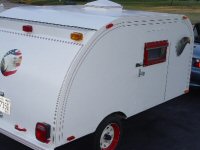chargin battery via 7-pin RV connector
44 posts
• Page 1 of 3 • 1, 2, 3
chargin battery via 7-pin RV connector
How long does it take to charge? Just bought a deep cycle battery a Costco and going on my first trip this weekend. I know it comes already charged but I'm wondering how long it takes to charge so I'm ready for my next camping trip. Do I need to buy a separate charger?
- E U G
- Teardrop Inspector
- Posts: 20
- Joined: Wed Aug 29, 2012 10:08 am
Re: chargin battery via 7-pin RV connector
I dunno. It depends upon the output of your alternator, the size of the wire from you alternator to the battery, the type of battery you have, and maybe other factors.
You might drain the battery down, make a dummy plug with the battery charge lead and ground stubbed out. Put the battery in your trunk and drive around as usual keeping a log of how long you drive and how long it takes to bring you battery back up to charge.
If you're gonna be camping where there is shore power a 4 amp (or more) charger, running 24 hours/day will provide you all the power you need (unless yer a real power hog) as it will keep your battery topped off all of the time and when you need more than 4 amps (or whatever the capacity of your charger is) your battery will supply the excess demand.
Given a battery and a reasonable charger I have never seen the need for one of the converters. They do, though, charge the battery but their capacity is far in excess, IMHO, for what I'd ever need.
Hope this helps.
Cheers,
Gus
You might drain the battery down, make a dummy plug with the battery charge lead and ground stubbed out. Put the battery in your trunk and drive around as usual keeping a log of how long you drive and how long it takes to bring you battery back up to charge.
If you're gonna be camping where there is shore power a 4 amp (or more) charger, running 24 hours/day will provide you all the power you need (unless yer a real power hog) as it will keep your battery topped off all of the time and when you need more than 4 amps (or whatever the capacity of your charger is) your battery will supply the excess demand.
Given a battery and a reasonable charger I have never seen the need for one of the converters. They do, though, charge the battery but their capacity is far in excess, IMHO, for what I'd ever need.
Hope this helps.
Cheers,
Gus
The opinions in this post are my own. My comments are directed to those that might like an alternative approach to those already espoused.There is the right way,the wrong way,the USMC way, your way, my way, and the highway.
"I'm impatient with stupidity. My people have learned to live without it." Klaatu-"The Day the Earth Stood Still"
"You can't handle the truth!"-Jack Nicholson "A Few Good Men"
"Some people spend an entire lifetime wondering if they made a difference in the world. The Marines don't have that problem"-Ronald Reagan
"I'm impatient with stupidity. My people have learned to live without it." Klaatu-"The Day the Earth Stood Still"
"You can't handle the truth!"-Jack Nicholson "A Few Good Men"
"Some people spend an entire lifetime wondering if they made a difference in the world. The Marines don't have that problem"-Ronald Reagan
-

eamarquardt - Silver Donating Member
- Posts: 3179
- Images: 150
- Joined: Sat Nov 11, 2006 11:00 pm
- Location: Simi Valley, State of Euphoria (Ca)




 Seems odd, that's almost the first question I had for the saleman who sold it to me. He didn't know either... So that's good to know a 2-hour drive would charge it up pretty good. Looks like I would need shore power to work my 110 outlets, and it won't charge the battery.
Seems odd, that's almost the first question I had for the saleman who sold it to me. He didn't know either... So that's good to know a 2-hour drive would charge it up pretty good. Looks like I would need shore power to work my 110 outlets, and it won't charge the battery. 